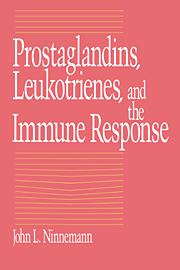Book contents
- Frontmatter
- Contents
- Foreword by James S. Goodwin
- Preface
- 1 A brief history and introduction
- 2 Prostaglandin/leukotriene structure and chemistry: a primer
- 3 Monocytes and macrophages
- 4 Lymphocyte response
- 5 Inflammation and the neutrophil
- 6 Malignancy and the arachidonic acid cascade
- 7 Tissue and organ transplantation
- 8 Rheumatoid arthritis and autoimmunity
- 9 Traumatic injury and surgery
- 10 Allergy
- Index
2 - Prostaglandin/leukotriene structure and chemistry: a primer
Published online by Cambridge University Press: 24 November 2009
- Frontmatter
- Contents
- Foreword by James S. Goodwin
- Preface
- 1 A brief history and introduction
- 2 Prostaglandin/leukotriene structure and chemistry: a primer
- 3 Monocytes and macrophages
- 4 Lymphocyte response
- 5 Inflammation and the neutrophil
- 6 Malignancy and the arachidonic acid cascade
- 7 Tissue and organ transplantation
- 8 Rheumatoid arthritis and autoimmunity
- 9 Traumatic injury and surgery
- 10 Allergy
- Index
Summary
The prostaglandins and the leukotrienes are families of oxygenated fatty acids, which have been detected in virtually every mammalian tissue thus far examined. These families include some of the most potent natural substances known. Prostaglandins/leukotrienes are not stored in tissues, however, as are biogenic amines. Rather, they are formed via the activity of specific enzymes immediately prior to their release. Synthesis takes place subsequent to any cell membrane disruption, which causes the release of free fatty acids from esterified lipid sources. The precise mechanism by which the precursors of prostaglandins/leukotrienes are released is not known; however, it is agreed that they originate from the phospholipid reserves in the cell membranes. Phospholipase A is recognized as an important enzyme in this release, and recent studies with platelets have shown that at least one additional enzyme, phosphatidylinositolspecific phospholipase C, will also release membrane diacylglycerides, which can subsequently be acted upon by various Upases to produce arachidonic acid (1).
Three primary, substrate fatty acids are currently recognized as prostaglandin/ leukotriene precursors. These are cis-5,8,11,14-eicosatetraenoic acid (arachidonic acid), and two related compounds, cis-8,11,14- eicosatrienoic acid, and cis-5,8,11,14,17-eicosapentaenoic acid. Arachidonic acid is considered to be the most important of the three, so much so that the biosynthetic pathway of prostaglandin/leukotriene production is generally referred to as the arachidonic acid cascade (Figure 2.1).
- Type
- Chapter
- Information
- Prostaglandins, Leukotrienes, and the Immune Response , pp. 12 - 33Publisher: Cambridge University PressPrint publication year: 1988
- 1
- Cited by



